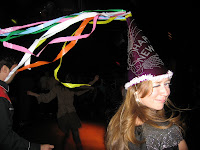
My good friend Stephanie is in Niamey, Niger (West Africa - see map) for 6 months. Today is her birthday, and since she's possibly one of the coolest people I know, I am going to tell you a little bit about what she is currently up to. She is in Niamey doing research on the women who undergo obstetrical fistula repair. For those of you who are not medical people, obstetrical fistula is essentially a tear in the wall of a woman's birth canal that results from childbirth gone wrong. That's the least graphic way I can describe it. Why does it occur? If a woman is in labor for an excessively long time, with the baby's head continually pushing against the mother's bones in the pelvic area, the pressure of the baby's head will cut off oxygen supply to the tissue adjacent to the bone. This dead tissue will have become a hole between the birth canal, plus the urethra and/or rectum - and the mother will most likely have delivered a stillborn baby. As if that isn't bad enough, she will then essentially leak urine or feces because of this hole, or fistula.
Obstetrical Fistula (O.F.) is a grave problem in underdeveloped parts of the world, including Africa. It is a complex issue involving many socioeconomic, anatomical and cultural issues. But some of the main reasons behind its prevalence are: girls often marry and deliver babies at a young age; their immature pelvises can have a hard time handling the demands of labor. Girls and women frequently labor in remote areas with limited to no access to modern medical care, including the C-sections that would be indicated in cases of prolonged, obstructed childbirth labor. These girls/women who incur O.F. may smell badly indefinitely until they are able to have the fistula repaired. You can read more about it at the UNFDP's website "Campaign to End Fistula" - see link above.
In recent years several "fistula repair centers" have cropped up across Africa. There has also been a fair amount of press coverage of the centers, of the patients who have had successful repairs, and even of the western medical teams who send over short term repair missions.
When Steph finished her MPH this past May, she started pondering the notion of fistula....afterall, she and I had spent over 2 years in Senegal as health extension volunteers with the Peace Corps. The topic interested her on a personal level - she had known women like the ones she read about, who'd experienced difficulties in childbirth. Here was a population of women who were making international headlines for "finding their way to repair centers in hopes of having OF repair surgery". Stories relayed the life-changing proceedures and how the women were healed and rid of all their worldly problems.
But Steph, who thrives on investigating public health situations first hand, wondered the following: what really happens to these women socially and emotionally through all this? If these patients were on the fringe of village life to begin with once they started leaking urine and smelling bad, were they allowed to return home after repair surgery? What was the experience of being at the hands of western medical teams like? And what were their hopes and fears about reintegrating back into their villages, far from the capital and the fistula center at the national hospital?
Steph took her inquiries to the Fulbight committee, and they, too, saw the value in having someone examine the situation on the ground. She was subsequently awarded a Fulbright grant to take a closer look at the experiences of these fistula patients. She is officially, as they are known in some parts, a "Fulbrighter". (Incidentally, I like saying "Fulbrighter" and try to work it into sentences as much as possible.)
She arrived in Niamey in December and will remain there through May. She has been interviewing the women who currently reside in the fistula compound of the National Hospital in Niamey and getting a sense of where they come from and where they may be headed after their surgeries. Her blog is linked here, so please refer to it for many more wonderful details chronicalling her time and work there.
The photo above is of Steph flipping through some charts of OF patients associated with the non-governmental organization (NGO) in Niamey called DIMOL

This photo is of Steph in front of DIMOL that I took of her in my first week there. DIMOL is one of many NGOs working with OF patients in some conjunction with the national hospital in Niamey, where they go for repair surgery.
This one is of one of the fistula patients:















